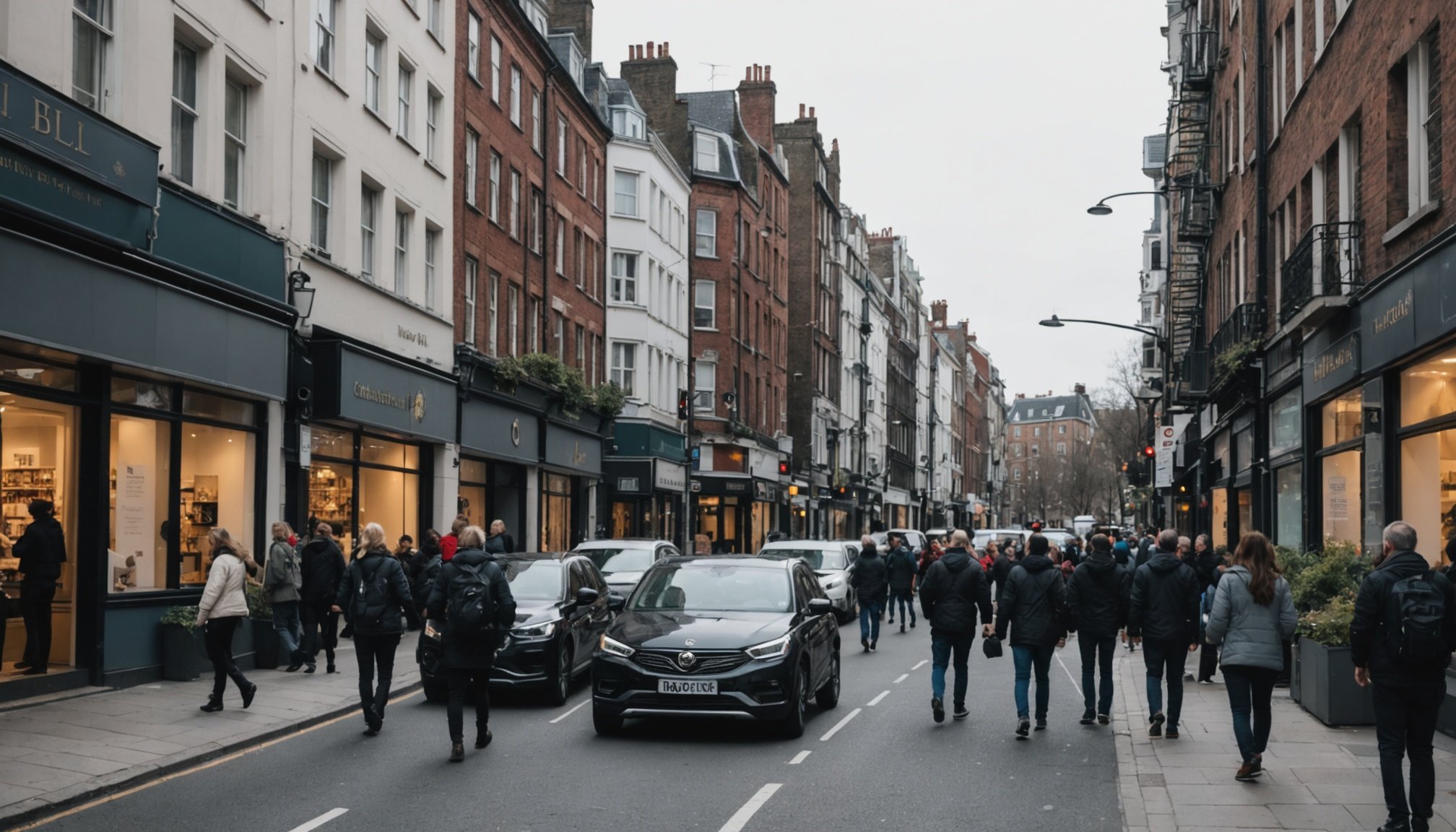Understanding Urban Noise Pollution
Urban noise pollution is an often overlooked aspect of city living, profoundly affecting our auditory environment. Defined as unwanted or harmful sound, it disrupts the natural soundscapes of urban areas. Sources can range from vehicular traffic to construction sites and bustling neighbourhood activities.
In cities worldwide, the auditory environment is saturated with a variety of noise types. Traffic noise, for instance, is a predominant component, often leading to elevated stress levels. Similarly, construction activities contribute high-intensity sounds. Even the hum of daily city life—people chatting, shops playing music—adds layers to the overall soundscape.
Also to read : Exploring the Impact of Plant-Powered Nutrition on Hormonal Harmony in Menopausal Women
Recent statistics reveal worrying trends. In many urban centres, noise levels exceed recommended limits by the World Health Organization. For instance, daytime urban noise often surpasses 55 decibels, a threshold beyond which health risks like hearing loss or sleep disturbances may occur.
Understanding these statistics can be critical. Addressing urban noise pollution requires acknowledging its pervasiveness and the subtle changes in soundscapes that significantly impact quality of life. Fostering quieter cities entails comprehensive strategies, prioritising health-focused sound management in auditory environments.
Topic to read : Exploring the Impact of Parental Engagement on Treatment Success in Juvenile Idiopathic Arthritis
The Link Between Noise Pollution and Stress
In bustling urban environments, noise pollution effects are frequently highlighted as significant urban stressors. Scientific studies have demonstrated a strong correlation between prolonged noise exposure and elevated stress levels. This relationship is largely attributed to the psychological impacts that incessant noise imposes on individuals.
Noise acts as a constant urban stressor, triggering the body’s stress response system. The auditory system is always alert, which results in a continuous release of stress hormones like cortisol. These hormones can lead to heightened anxiety, disruptive sleep patterns, and even long-term health issues if exposure persists.
From a psychological perspective, noise can interfere with concentration, elevate frustration, and diminish overall well-being. Loud environments often hamper the ability to focus, leading to increased irritation and decreased productivity. For those residing in highly noise-polluted areas, this results in a perpetual state of unease, which may contribute to chronic stress conditions.
Personal accounts often highlight how individuals experience stress due to noise, whether from bustling city streets or construction work. These anecdotes underline how noise can permeate daily life, affecting mental health and overall satisfaction. Understanding and mitigating these impacts could significantly enhance quality of life in urban settings.
Health Implications of Urban Noise Pollution
Urban noise pollution is a growing concern with significant health effects. In bustling metropolitan areas, residents often face constant noise from traffic, construction, and crowded living conditions. This persistent soundscape can contribute to various physical health issues, including cardiovascular disorders. Studies have shown a correlation between chronic exposure to high noise levels and increased risks of hypertension, heart disease, and even stroke.
Living in noisy urban environments doesn’t only affect adults; children and the elderly are particularly vulnerable. Prolonged exposure to such noise can lead to chronic stress, which might impair immune function. Vulnerable populations, like those with pre-existing health conditions or lower socio-economic status, may experience heightened risks.
Furthermore, urban living can exacerbate mental health challenges. High noise pollution has been linked to increased incidence of anxiety and depression. The constant barrage of sound interrupts sleep patterns, impacting one’s overall well-being and productivity.
In sum, the health effects of urban noise are profound, urging city dwellers to be aware of their environments and potential consequences. Addressing these issues involves both individual actions, like using soundproofing at home, and policy-level interventions to create quieter urban spaces.
Case Studies: Urban Noise and Resident Stress
Understanding how urban noise affects residents is crucial for effective urban planning. Case studies highlight areas like New York City and San Francisco, where noise pollution significantly impacts community well-being. These locations illustrate the stark realities and challenges communities face amid constant auditory assaults.
Residents in these high-noise neighborhoods frequently report heightened stress levels. They experience difficulty sleeping, increased irritability, and adverse health effects. Insights from community members reveal the pervasive nature of noise, underscoring the need for interventions.
Luckily, some areas have pioneered successful noise mitigation strategies. In Toronto, for instance, urban planners implemented noise barriers and traffic flow adjustments. These initiatives notably improved residents’ quality of life, showcasing how targeted solutions can enhance living conditions.
By examining these urban planning examples, cities can address and alleviate community impact. Deploying community impact interventions fosters a healthier, more pleasant urban environment. Through continued research and application of best practices, cities worldwide can manage noise pollution effectively.
Such proactive measures not only reduce stress levels but also empower residents to thrive, leading to more harmonious urban living spaces.
Strategies for Mitigating Noise Pollution
Urban areas often grapple with the challenge of managing excess noise. Noise reduction strategies can significantly improve the quality of life for residents. One key approach involves innovative urban planning solutions that incorporate green spaces and acoustic barriers. These plans are designed to dissipate sound and provide natural breaks in populated areas, reducing the overall noise impact.
For residents looking to minimise noise impact at home, there are several practical tips that can be employed. Installing double-glazed windows and thick curtains can help block external sounds. Additionally, using rugs and carpets on hard floors can muffle internal noise echoes, making domestic environments more serene.
Community initiatives play a vital role in effective noise management. Engaging with local councils and community groups allows residents to voice their concerns and participate in developing urban planning solutions that cater to their specific needs. Collaborative efforts can lead to the implementation of soundproofing materials in public buildings and awareness campaigns to educate the populace on noise reduction strategies.
Harnessing the power of technology, local authorities can monitor noise levels in real-time and enact changes promptly, demonstrating how strategic community cooperation can achieve sustainable noise mitigation.
Enhancing Quality of Life in Noisy Cities
Navigating urban environments demands effective stress reduction techniques. Residents can significantly improve their quality of life by embracing methods that foster urban resilience. This involves exploring a mix of individual and community strategies designed to cope with city’s unique challenges.
Integrating green spaces is a well-regarded approach to reduce stress levels in bustling environments. Parks and natural areas serve as crucial buffers against city noise, providing serene retreats that promote mental well-being. Urban planners are now focusing on the incorporation of these spaces as part of sustainable city development, emphasizing the importance of accessible leisure to healthier living.
Acoustic design also plays a pivotal role in urban resilience. Innovative architectural approaches seek to minimize the impact of noise pollution, offering quieter interiors through effective soundproofing and layout plans. These designs advocate for peaceful environments, enhancing daily life amid the city’s hustle.
Community resources are equally vital. Access to wellness programs, local support groups, and mental health services provide essential networks for stress management. These resources enable individuals to collaboratively tackle stressors, fostering a supportive urban community that champions collective resilience and improved quality of life.











